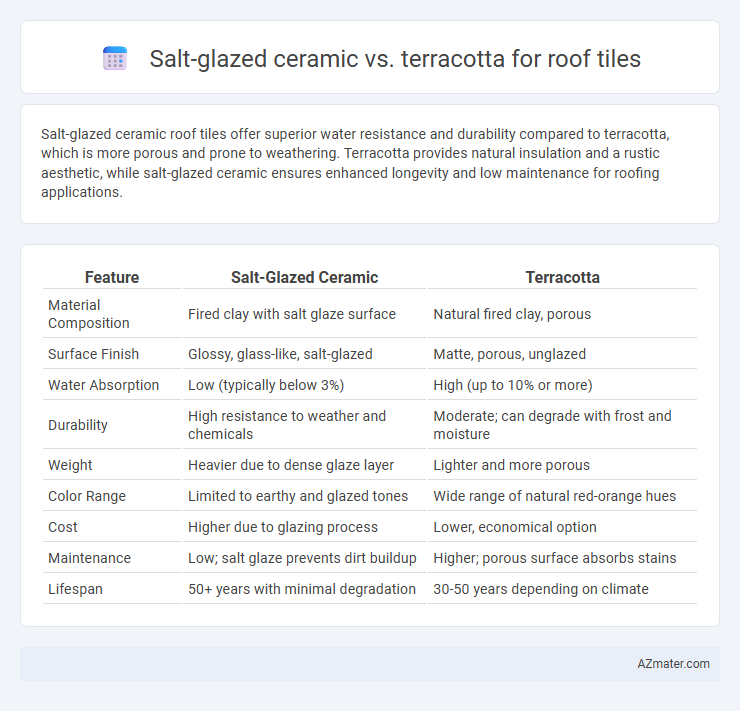Salt-glazed ceramic roof tiles offer superior water resistance and durability compared to terracotta, which is more porous and prone to weathering. Terracotta provides natural insulation and a rustic aesthetic, while salt-glazed ceramic ensures enhanced longevity and low maintenance for roofing applications.
Table of Comparison
| Feature | Salt-Glazed Ceramic | Terracotta |
|---|---|---|
| Material Composition | Fired clay with salt glaze surface | Natural fired clay, porous |
| Surface Finish | Glossy, glass-like, salt-glazed | Matte, porous, unglazed |
| Water Absorption | Low (typically below 3%) | High (up to 10% or more) |
| Durability | High resistance to weather and chemicals | Moderate; can degrade with frost and moisture |
| Weight | Heavier due to dense glaze layer | Lighter and more porous |
| Color Range | Limited to earthy and glazed tones | Wide range of natural red-orange hues |
| Cost | Higher due to glazing process | Lower, economical option |
| Maintenance | Low; salt glaze prevents dirt buildup | Higher; porous surface absorbs stains |
| Lifespan | 50+ years with minimal degradation | 30-50 years depending on climate |
Introduction to Salt-Glazed Ceramic and Terracotta Roof Tiles
Salt-glazed ceramic roof tiles feature a glassy, glossy surface created by a salt vapor glazing process during firing, resulting in enhanced water resistance and durability against weathering. Terracotta roof tiles are crafted from natural clay, fired at lower temperatures, and exhibit a porous, earthy texture that offers excellent breathability and traditional aesthetic appeal. Both materials provide distinct advantages for roofing, with salt-glazed ceramic emphasizing longevity and low maintenance, while terracotta focuses on natural insulation and classic design.
Material Composition and Manufacturing Processes
Salt-glazed ceramic roof tiles consist of clay mixed with feldspar and silica, which undergo a high-temperature firing process where common salt is introduced to create a glossy, glass-like surface. Terracotta tiles are made primarily from natural clay and iron oxide, shaped and then fired at lower temperatures, resulting in a porous and matte finish. The salt glazing technique enhances durability and water resistance in ceramic tiles, whereas terracotta's traditional composition emphasizes breathability and thermal insulation.
Durability and Weather Resistance Comparison
Salt-glazed ceramic roof tiles exhibit superior durability and weather resistance compared to terracotta due to their vitrified, glass-like surface that repels water and resists frost damage. Terracotta tiles, though naturally breathable and aesthetically warm, are more porous, making them susceptible to cracking and wear in extreme weather conditions. The denser composition and enhanced hardness of salt-glazed ceramics ensure longer lifespan and better performance in harsh climates.
Aesthetic Appeal and Color Retention
Salt-glazed ceramic roof tiles offer a distinctive glossy finish with vibrant color retention due to the vitrification process during firing, making them highly resistant to fading and weathering. Terracotta roof tiles provide a warm, earthy aesthetic with natural matte textures that develop a charming patina over time but may experience more noticeable color changes under prolonged sun exposure. Both materials enhance architectural appeal, with salt-glazed ceramics favoring long-lasting brightness and terracotta emphasizing rustic, evolving color tones.
Installation Requirements and Techniques
Salt-glazed ceramic roof tiles require precise kiln firing to achieve their characteristic glossy, durable surface, ensuring optimal weather resistance and longevity. Installation demands careful handling due to their brittleness and specific overlap techniques to maintain waterproofing and structural integrity. Terracotta tiles, with their natural breathable composition, allow for easier cutting and shaping on-site, supporting rapid installation but necessitating proper underlayment to prevent moisture penetration.
Cost Differences and Long-Term Value
Salt-glazed ceramics typically cost more upfront than terracotta due to their complex manufacturing process and enhanced durability. Terracotta offers a lower initial price but may require more maintenance and replacement over time, affecting long-term expenses. Investing in salt-glazed tiles often results in better resistance to weathering and lower lifecycle costs compared to the porous nature of terracotta.
Environmental Impact and Sustainability
Salt-glazed ceramic roof tiles offer enhanced durability and resistance to weathering, reducing the need for frequent replacement and minimizing waste. Terracotta tiles, made from natural clay, are biodegradable and have a lower carbon footprint in production but may require more energy-intensive maintenance due to their porous nature. Choosing between salt-glazed ceramic and terracotta involves balancing long-term sustainability with the environmental costs of manufacturing and lifecycle performance.
Maintenance Needs and Lifespan
Salt-glazed ceramic roof tiles offer superior durability and low maintenance due to their vitrified, non-porous surface that resists moisture and mold growth, extending their lifespan beyond 50 years. Terracotta roof tiles, made from natural clay, require regular sealing and cleaning to prevent water absorption and efflorescence, which can reduce their functional lifespan to around 30-50 years depending on environmental exposure. Choosing salt-glazed ceramic improves long-term maintenance efficiency and durability in diverse climate conditions compared to traditional terracotta.
Regional Suitability and Climate Considerations
Salt-glazed ceramic roof tiles, known for their dense, water-resistant surface, excel in humid and rainy climates common in northern Europe due to their ability to prevent moisture infiltration and frost damage. Terracotta tiles, with their porous texture and natural thermal insulation properties, are more suitable for hot, dry regions such as the Mediterranean, where they help regulate indoor temperatures by absorbing and slowly releasing heat. Regional geology and local clay quality also influence tile durability and performance, making it essential to choose between salt-glazed ceramic and terracotta based on specific climate challenges and environmental conditions to maximize roof longevity and energy efficiency.
Choosing the Right Roof Tile for Your Project
Salt-glazed ceramic roof tiles offer superior durability and water resistance, making them ideal for regions with heavy rainfall or freeze-thaw cycles, while terracotta tiles provide excellent breathability and a natural, earthy aesthetic suited to warm, dry climates. When choosing the right roof tile for your project, consider factors such as climate conditions, maintenance requirements, and architectural style to ensure both functionality and visual appeal. Salt-glazed ceramics typically demand higher upfront costs but deliver long-term resilience, whereas terracotta remains cost-effective with a timeless, rustic charm.

Infographic: Salt-glazed ceramic vs Terracotta for Roof Tile
 azmater.com
azmater.com